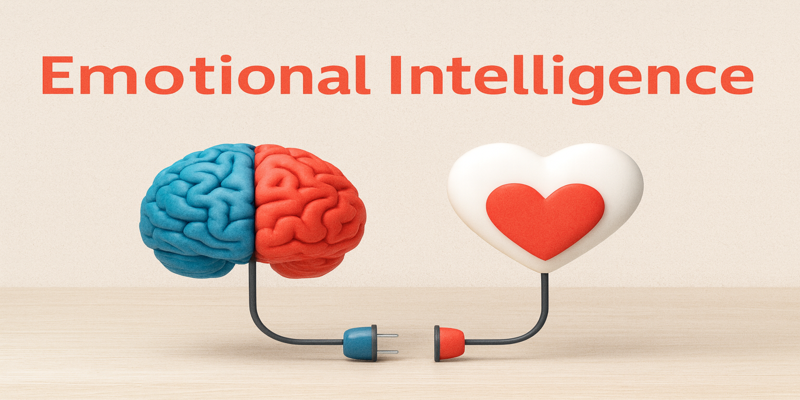Emotional Intelligence: Do’s and Don’ts in the Workplace
In today’s complex organisational environments, emotional intelligence (EI) has emerged as one of the most valuable competencies for professional success. Defined by Goleman (1995) as the ability to recognise, understand, and regulate one’s emotions while influencing those of others, EI plays a vital role in enhancing communication, teamwork, and leadership effectiveness. The infographic “Emotional Intelligence: Do’s and Don’ts and Why They Matter” outlines essential workplace behaviours that strengthen interpersonal relationships and organisational performance. This article explores the practical application of emotional intelligence in professional settings, focusing on conflict resolution, communication, stress management, and feedback. Drawing upon current academic research and real-world examples, it examines how emotionally intelligent actions lead to better outcomes, and why emotionally unintelligent responses can damage morale and productivity. 1.0 When a Co-worker Seems Upset Do: Ask if they are okay and offer to listen. Don’t: Ignore their feelings or pry for details. Why it matters: Shows empathy and builds trust. Empathy—the ability to perceive and relate to others’ emotions—is a cornerstone of social awareness, one of Goleman’s five EI domains. Studies by Ufomba and Udensi (2024) show that empathetic communication fosters trust, team cohesion, and a positive climate. Acknowledging a colleague’s emotions helps prevent feelings of isolation and promotes psychological safety (Edmondson, 2019). A real-world example can be seen at Microsoft, where CEO Satya Nadella redefined leadership culture through empathy. His approach encouraged managers to listen actively and support team members during challenges, leading to measurable increases in innovation and engagement (Gallo, 2022). 2.0 During Team Disagreements Do: Stay calm and look for common ground. Don’t: Take sides or get defensive. Why it matters: Helps find solutions and maintain peace. Team disagreements are inevitable in dynamic workplaces. However, emotionally intelligent individuals approach conflict with self-regulation—managing impulses, avoiding reactive behaviour, and seeking constructive outcomes. According to Sinan (2025), emotionally intelligent leaders facilitate collaborative problem-solving by focusing on shared goals rather than personal agendas. This aligns with Goleman’s framework of relationship management, which emphasises diplomacy and communication as critical leadership tools. A good example is the Agile Project Management model, where emotionally intelligent leaders foster collaboration across cross-functional teams, reducing tension and improving project outcomes (Sinan, 2025). 3.0 When You Disagree with a Decision Do: Ask questions to understand why. Don’t: Complain to others behind closed doors. Why it matters: Promotes open communication and respect. Disagreements can strengthen organisational culture when handled appropriately. Asking clarifying questions demonstrates self-awareness and a desire to understand rather than resist. As Mamata and Kavilal (2025) note, emotionally intelligent employees manage dissent through dialogue and curiosity rather than gossip or defiance. Constructive questioning also aligns with transformational leadership theory, where openness fosters trust and transparency (Bass & Riggio, 2006). For instance, at Google, managers are encouraged to challenge ideas respectfully in open forums, ensuring innovation through honest yet emotionally intelligent communication (Schmidt & Rosenberg, 2014). 4.0 When Facing a Tough Challenge Do: Ask for help or advice when needed. Don’t: Pretend you have all the answers. Why it matters: Encourages teamwork and learning. Acknowledging limitations is a key component of emotional maturity. Emotionally intelligent professionals understand that vulnerability and collaboration often lead to stronger problem-solving outcomes. Research by Segbenya and Amissah-Wilson (2024) found that emotionally intelligent employees in developing economies demonstrated higher productivity by engaging collaboratively and acknowledging areas for improvement. This finding reinforces the importance of social intelligence and interpersonal competence in team performance. A practical illustration comes from Unilever, where teams operate under a culture of “collective intelligence”—encouraging open discussion of challenges without fear of judgment (Unilever, 2022). 5.0 During Stressful Projects Do: Take short breaks to reset. Don’t: Let stress affect how you treat others. Why it matters: Maintains a positive work environment. The ability to manage stress effectively reflects emotional resilience, an essential aspect of self-regulation. High stress can impair decision-making and strain relationships if not managed well. According to Odame and Pandey (2025), emotional intelligence correlates strongly with stress reduction and improved mental health outcomes in leadership roles. Leaders who practice mindfulness and emotional control are better equipped to maintain team morale during high-pressure situations. Organisations like SAP and Deloitte have introduced mindfulness-based EI training to help employees recognise stress triggers and respond constructively, leading to measurable reductions in burnout and absenteeism (Harvard Business Review, 2023). 6.0 When Receiving Feedback Do: Listen fully and thank them for input. Don’t: Argue or dismiss their points. Why it matters: Shows openness to growth and respect. Feedback, when approached with self-awareness and humility, becomes a catalyst for growth. Emotionally intelligent professionals view feedback not as criticism but as an opportunity to improve. Research by Radha and Nirubarani (2024) in the banking sector found that emotionally intelligent employees respond to feedback with adaptability and appreciation, improving overall performance. Leaders can reinforce this by modelling gratitude and curiosity when receiving critique. Example: At Adobe, the “Check-In” feedback system replaces annual reviews with regular, informal conversations that promote trust, emotional openness, and performance improvement (Forbes, 2023). 7.0 If You’re Having a Bad Day Do: Let your team know you might need space. Don’t: Take it out on others or act cold. Why it matters: Keeps your mood from affecting the team. Emotional contagion—the phenomenon where emotions spread within a group—means that leaders’ moods significantly impact team morale (Goleman, 2013). Acknowledging when you’re not at your best demonstrates emotional responsibility and prevents miscommunication. As Ugoani (2024) notes, emotionally intelligent managers in Nigerian organisations used emotional self-regulation to maintain composure, reducing conflict and maintaining harmony during crises. This supports the view that awareness and honesty about one’s emotional state protect team productivity. 8.0 Before Sending an Important Email Do: Read it over and check your tone. Don’t: Write and send when you’re upset. Why it matters: Prevents misunderstandings and conflicts. Digital communication lacks non-verbal cues, making tone management essential. Emotionally intelligent communicators pause, reflect, and reread their messages to ensure clarity and respect. A study by Paiva (2024) underscores the role of emotional intelligence in digital correspondence, showing that leaders with higher EI scores crafted … Read more










